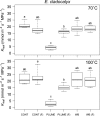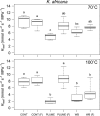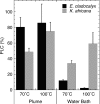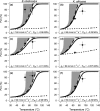Experimental evidence for heat plume-induced cavitation and xylem deformation as a mechanism of rapid post-fire tree mortality
- PMID: 27152877
- PMCID: PMC5084795
- DOI: 10.1111/nph.13979
Experimental evidence for heat plume-induced cavitation and xylem deformation as a mechanism of rapid post-fire tree mortality
Abstract
Recent work suggests that hydraulic mechanisms, rather than cambium necrosis, may account for rapid post-fire tree mortality. We experimentally tested for xylem cavitation, as a result of exposure to high-vapour-deficit (D) heat plumes, and permanent xylem deformation, as a result of thermal softening of lignin, in two tree species differing in fire tolerance. We measured percentage loss of conductance (PLC) in distal branches that had been exposed to high-D heat plumes or immersed in hot water baths (high temperature, but not D). Results were compared with predictions from a parameterized hydraulic model. Physical damage to the xylem was examined microscopically. Both species suffered c. 80% PLC when exposed to a 100°C plume. However, at 70°C, the fire-sensitive Kiggelaria africana suffered lower PLC (49%) than the fire-resistant Eucalytpus cladocalyx (80%). Model simulations suggested that differences in PLC between species were a result of greater hydraulic segmentation in E. cladocalyx. Kiggelaria africana suffered considerable PLC (59%), as a result of heat-induced xylem deformation, in the water bath treatments, but E. cladocalyx did not. We suggest that a suite of 'pyrohydraulic' traits, including hydraulic segmentation and heat sensitivity of the xylem, may help to explain why some tree species experience rapid post-fire mortality after low-intensity fires and others do not.
Keywords: Eucalyptus cladocalyx; Kiggelaria africana; cavitation; fire; hydraulic failure; pyrohydraulics; tree mortality; xylem deformation.
© 2016 The Authors. New Phytologist © 2016 New Phytologist Trust.
Figures






Similar articles
-
Hydraulic segmentation explains differences in loss of branch conductance caused by fire.Tree Physiol. 2023 Dec 12;43(12):2121-2130. doi: 10.1093/treephys/tpad108. Tree Physiol. 2023. PMID: 37672220 Free PMC article.
-
Moving beyond the cambium necrosis hypothesis of post-fire tree mortality: cavitation and deformation of xylem in forest fires.New Phytol. 2012 Apr;194(1):254-263. doi: 10.1111/j.1469-8137.2011.04021.x. Epub 2012 Jan 25. New Phytol. 2012. PMID: 22276783
-
Using heat plumes to simulate post-fire effects on cambial viability and hydraulic performance in Sequoia sempervirens stems.Tree Physiol. 2023 May 12;43(5):769-780. doi: 10.1093/treephys/tpad006. Tree Physiol. 2023. PMID: 36715648
-
Fire effects on tree physiology.New Phytol. 2019 Sep;223(4):1728-1741. doi: 10.1111/nph.15871. Epub 2019 May 22. New Phytol. 2019. PMID: 31032970 Review.
-
Water relations in tree physiology: where to from here?Tree Physiol. 2017 Jan 31;37(1):18-32. doi: 10.1093/treephys/tpw102. Tree Physiol. 2017. PMID: 28173481 Review.
Cited by
-
A Structure Shaped by Fire, but Also Water: Ecological Consequences of the Variability in Bark Properties Across 31 Species From the Brazilian Cerrado.Front Plant Sci. 2020 Jan 22;10:1718. doi: 10.3389/fpls.2019.01718. eCollection 2019. Front Plant Sci. 2020. PMID: 32038687 Free PMC article.
-
Relevance of time and spatial scales in plant hydraulics.Tree Physiol. 2021 Oct 4;41(10):1781-1784. doi: 10.1093/treephys/tpab093. Tree Physiol. 2021. PMID: 34296269 Free PMC article. No abstract available.
-
Integrating plant physiology into simulation of fire behavior and effects.New Phytol. 2023 May;238(3):952-970. doi: 10.1111/nph.18770. Epub 2023 Feb 14. New Phytol. 2023. PMID: 36694296 Free PMC article. Review.
-
Fire-scarred fossil tree from the Late Triassic shows a pre-fire drought signal.Sci Rep. 2020 Nov 18;10(1):20104. doi: 10.1038/s41598-020-77018-w. Sci Rep. 2020. PMID: 33208853 Free PMC article.
-
Tree mortality after a spring fire: the role of reduced live leaf area in depletion of early growing season bole NSC.Tree Physiol. 2024 Jul 2;44(7):tpae063. doi: 10.1093/treephys/tpae063. Tree Physiol. 2024. PMID: 38924717 Free PMC article. No abstract available.
References
-
- Aerts V. 2015. Physiological responses of Australian native and agricultural plant species to smoke from bushfires and prescribed burns. PhD thesis, Faculty of Agriculture and the Environment, University of Sydney, Sydney, New South Wales, Australia.
-
- Balfour DA, Midgley JJ. 2006. Fire induced stem death in an African acacia is not caused by canopy scorching. Austral Ecology 31: 892–896.
-
- Bell TL, Stephens SL, Moritz MA. 2013. Short‐term physiological effects of smoke on grapevine leaves. International Journal of Wildland Fire 22: 933–946.
-
- Bond WJ, Keeley JE. 2005. Fire as a global ‘herbivore’: the ecology and evolution of flammable ecosystems. Trends in Ecology & Evolution 20: 387–394. - PubMed
-
- Bond WJ, Midgley GF. 2000. A proposed CO2‐controlled mechanism of woody plant invasion in grasslands and savannas. Global Change Biology 6: 865–869.
Publication types
MeSH terms
LinkOut - more resources
Full Text Sources
Other Literature Sources

